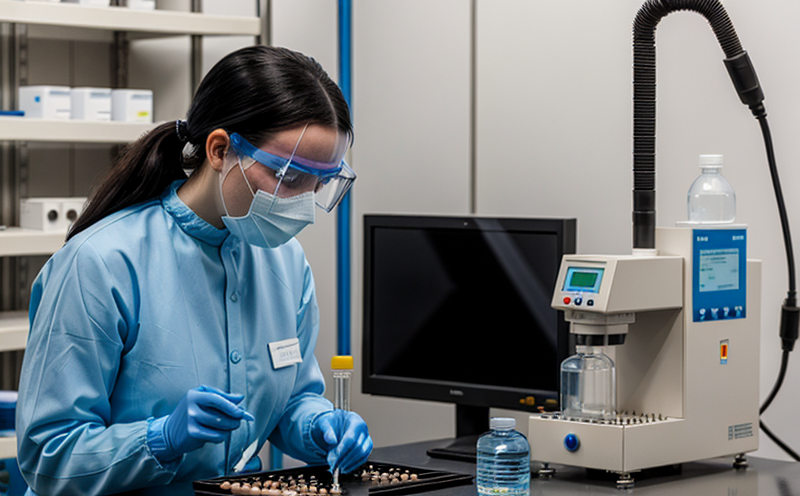HPLC Assay Testing for Active Ingredient Content
High-Performance Liquid Chromatography (HPLC) assay testing is a critical analytical technique used to determine the active ingredient content within pharmaceutical products. This method ensures that the final product meets the required specifications and standards, which are essential for patient safety and efficacy.
The process of HPLC involves the separation of different components in a sample using liquid as a solvent. The efficiency of this technique lies in its ability to differentiate between closely related compounds based on their size, charge, hydrophobicity, or other properties. This precision is particularly crucial for pharmaceuticals where even small deviations can lead to significant discrepancies in efficacy and safety.
In the context of active ingredient content determination, HPLC uses a column packed with stationary phases that interact selectively with certain analytes. The mobile phase, typically an aqueous or organic solvent, carries the sample through the column, causing various components to elute at different times depending on their interaction with the stationary phase.
The heart of this process is the detector, which monitors the passage of compounds through the column and translates it into a signal. For HPLC analysis, UV-visible detectors are commonly used, detecting the absorbance of light by the sample as it passes through the detector. The resulting chromatogram provides a visual representation of the components present in the sample, allowing for precise quantification of each component.
The accuracy and reliability of HPLC depend heavily on several factors including the quality of the column, the composition of the mobile phase, temperature control, and flow rate settings. These parameters must be meticulously controlled to ensure consistent results across multiple runs. Additionally, calibration standards are used to establish a reference point for quantification.
When performing HPLC assay testing on active ingredients, it is vital to follow strict protocols that align with international standards such as ISO 17025 and ICH Q6A. These guidelines ensure that the laboratory maintains high-quality systems and processes, which are essential for producing accurate results.
The importance of HPLC assay testing cannot be overstated. It plays a pivotal role in quality control, ensuring that each batch of pharmaceuticals contains the correct amount of active ingredient as stated on the label. This not only upholds regulatory compliance but also enhances patient trust and safety. By adhering to these stringent testing protocols, pharmaceutical companies can ensure their products meet the highest standards of efficacy and purity.
Why It Matters
HPLC assay testing for active ingredient content is crucial in ensuring that pharmaceutical products are safe, effective, and compliant with regulatory requirements. Regulatory bodies such as the FDA, EMA, and WHO mandate these tests to ensure product quality and patient safety.
Accurate quantification of active ingredients helps prevent issues related to underdosing or overdosing, which can have severe health implications. Inaccurate dosing may lead to ineffective treatment for patients with chronic conditions, while excessive amounts could cause adverse side effects. By maintaining consistent active ingredient content across all batches, pharmaceutical manufacturers uphold the integrity of their brand and reputation.
Compliance with regulatory standards is not just a legal requirement but also a commitment to excellence. Regulatory bodies like the FDA and EMA provide detailed guidelines for conducting HPLC assays, emphasizing the importance of method validation and robust quality control processes. These regulations ensure that laboratories are equipped with the necessary expertise and resources to perform these tests accurately.
The significance of HPLC assay testing extends beyond individual batches; it contributes to long-term product stability and efficacy. Consistent results across multiple runs demonstrate the reliability of manufacturing processes, which is vital for maintaining consistent quality over time. This consistency builds trust with healthcare professionals and patients, fostering a positive brand image.
Industry Applications
HPLC assay testing finds extensive use across various sectors within the pharmaceutical industry. It is integral in drug development, manufacturing, quality control, and regulatory compliance. During drug development, HPLC helps identify impurities that could affect product efficacy or safety.
In manufacturing, this technique ensures that each batch of active ingredients meets specified purity levels, adhering to stringent quality standards set by regulatory agencies. Quality control departments rely on HPLC to monitor production processes and detect any deviations from expected parameters promptly.
For regulatory compliance, pharmaceutical companies must demonstrate adherence to international standards such as ICH Q6A and ISO 17025. These standards provide a framework for laboratories to establish robust testing methods, ensuring accurate results that meet global requirements.
HPLC also plays a crucial role in clinical trials by providing reliable data on active ingredient content before products reach the market. This ensures that patients receive treatments that are both safe and effective.
Competitive Advantage and Market Impact
In today’s competitive pharmaceutical landscape, maintaining high standards of quality is paramount for sustaining a strong market position. HPLC assay testing not only ensures compliance with regulatory requirements but also enhances product reliability and patient safety.
Laboratories that specialize in HPLC assay testing offer significant advantages to pharmaceutical companies. By providing accurate and consistent results, these labs help manufacturers build trust with healthcare professionals and patients. This trust translates into increased market credibility and customer loyalty, ultimately driving sales growth.
Moreover, adherence to international standards such as ICH Q6A positions these laboratories at the forefront of industry best practices. This not only enhances their reputation but also opens doors to new business opportunities within the global pharmaceutical sector.
The ability to consistently produce reliable results across multiple batches contributes significantly to a company’s operational efficiency and cost-effectiveness. By minimizing errors and rejections, companies can streamline their production processes, reducing waste and lowering overall costs.





